799. White-browed Sparrow-weaver Plocepasser mahali (Koringvoël)
Order: Passeriformes. Family: Ploceidae
Description
Boldly marked. It is 17-19 cm in length and is characterized by a broad, white bulging, supercilium but a blackish forehead and crown, and white rump visible in flight. Brown above, very broad white tips to the wing-coverts. The head is brown. It has a white coloured throat and rump. Brown legs. The eyes are brown.
Northern race pectoralis has brown spots on breast and a reddish-brown back.
Sexes are alike in plumage. The male has a black bill, the female's bill is buff horn-colored; that of the juvenile is pinkish-brown.
Similar species: The broad, white eyebrow extending well behind the eye and on to the nape of this bird is vaguely reminiscent of the same feature in the Yellow-throated Petronia, but the White-browed Sparrow-weaver is much larger and shows a white rump in fllight.
Distribution: It is found in greatest numbers in north-central southern Africa. It mainly occurs in two separate areas of sub-Saharan Africa; one extending from Ethiopia through Somalia and Kenya to Tanzania, with a larger population from Zambia to Tanzania south to southern Africa. Here it is locally common to abundant across much of the region, excluding most of Mozambique and the southern and eastern provinces of South Africa.
Taxonomy
There are four recognized subspecies of the White-browed Sparrow-Weaver.
P. m. mahali is found in the eastern part of the northern Cape Province of South Africa
P. m. stentor is found from the western part of the northern Cape Province northwards along the Namibian escarpment
P. m. terricolor is found towards the center of the White-Browed Sparrow-Weaver's range, occurring predominantly in eastern Botswana
P. m. pectoralis is found in northeastern Zimbabwe along the lower Zambezi river
Habitat
It is mainly found in light and densely wooded forests and prefers semi-arid Acacia and Mopane (Colosphermum mopane) savanna woodland.
Breeding
Monogamous, colonial cooperative breeder, living in groups within which each bird has their own nest. The average colony size is 16 nests. However there can only be one active breeding pair per group who are usually the largest in size, remaining dominant until their death, at which point another pair steps up to the plate. The group are highly territorial, vigorously defending their ca. 50 m long foraging territory, often chasing intruders out of the territory. The nest is built by both breeders in about 5-30 days but maintained throughout the year, consisting of an untidy, retort-shaped structure made of dry grass, with two entrances one of which is closed by the breeding pair. It is typically wedged into the branches of a thorny tree, but it may also use telephone wires, power lines and fences. It breeds opportunistically in response to rainfall, with egg-laying season peaking from June-December. It lays 1-3 eggs, which are incubated solely by the dominant female for about 14 days. The chicks are fed by the breeding female only for the first few days of their lives, after which all group members contribute. They leave the nest at about 21-23 days old, remaining dependent on the group for at least one month more.
Occasionally parasitised by Diderick Cuckoo in Zimbabwe.
Call
Noisy species; song a series of chattering and squealing phrases. Listen to Bird Call.
Status
Common resident. In pairs but more usually in small groups.
Africa Wild Bird Book
White-browed Sparrow-Weaver Photos
799. White-browed Sparrow-weaver Plocepasser mahali

Male
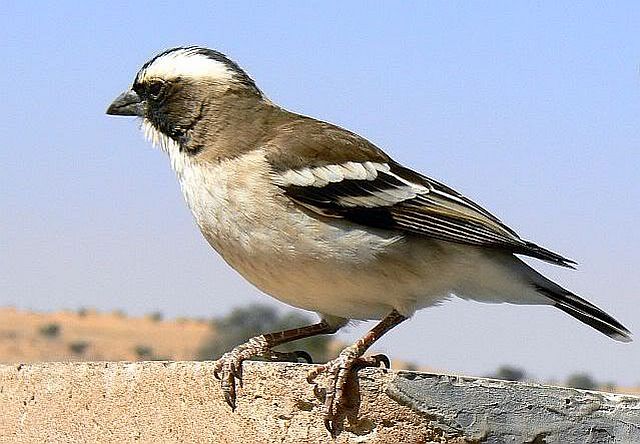 © Toko
© Toko
Male, Kgalagadi Transfrontier Park
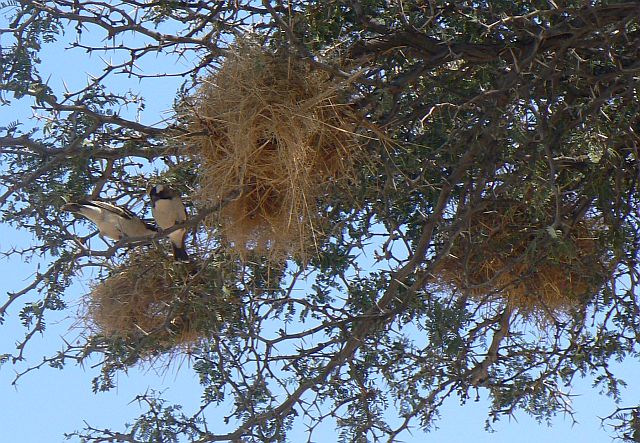 © Toko
© Toko
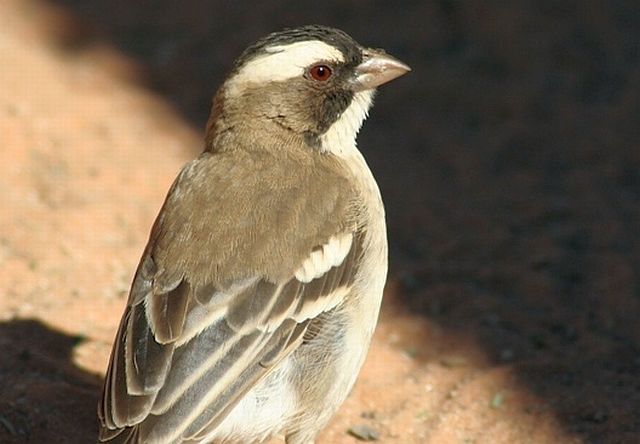 © pooky
© pooky
Female
 © Dewi
© Dewi
Female
 © ExFmem
© ExFmem
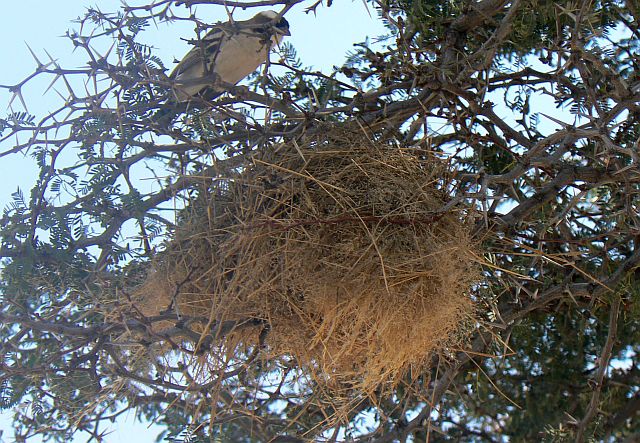
White-browed Sparrow-Weavers live in stable, territorial groups of 2-11 birds; a group consits of one breeding pair and other nonreproductives. Not all of the many nests in the nest tree of group are used for breeding or roosting. The nests have an inverted U-shaped form. There are two types of nests: breeding nests and roosting nests. The breeding nests have only one entrance, but the roost nests have two entrances, one at either end. About 90% of the nests are roosting nests. Breeding nests. Sometimes roost nests are changed to breeding nests and vice versa, the birds do just open or close one entrance.
 © nan
© nan
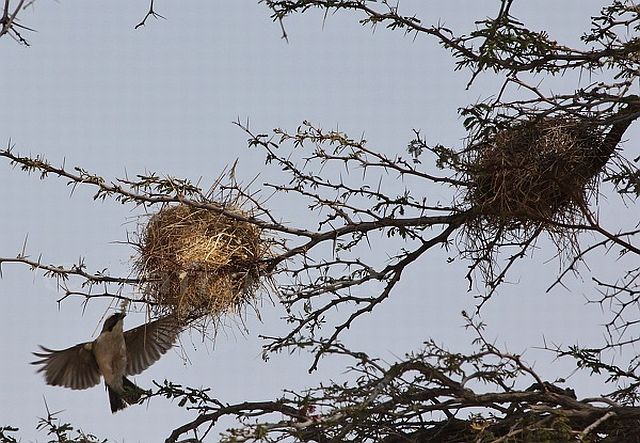 © nan
© nan
 © nan
© nan
Links:
Species text in The Atlas of Southern African Birds
Sabap2
Weaver Wednesday: White-browed Sparrow-Weaver

Male
 © Toko
© TokoMale, Kgalagadi Transfrontier Park
 © Toko
© Toko © pooky
© pookyFemale
 © Dewi
© DewiFemale
 © ExFmem
© ExFmem
White-browed Sparrow-Weavers live in stable, territorial groups of 2-11 birds; a group consits of one breeding pair and other nonreproductives. Not all of the many nests in the nest tree of group are used for breeding or roosting. The nests have an inverted U-shaped form. There are two types of nests: breeding nests and roosting nests. The breeding nests have only one entrance, but the roost nests have two entrances, one at either end. About 90% of the nests are roosting nests. Breeding nests. Sometimes roost nests are changed to breeding nests and vice versa, the birds do just open or close one entrance.
 © nan
© nan © nan
© nan © nan
© nanLinks:
Species text in The Atlas of Southern African Birds
Sabap2
Weaver Wednesday: White-browed Sparrow-Weaver
- Mel
- Global Moderator
- Posts: 26737
- Joined: Sat May 19, 2012 12:31 pm
- Country: Germany
- Location: Föhr
- Contact:
Sociable Weaver
800. Sociable Weaver Philetairus socius (Versamelvloël)
Order: Passeriformes. Family: Ploceidae
Description
Pale bill offset by black face and throat diagnostic. A buff brown bird with a conspicuous black chin and its whitish underparts. They have blackish back and wings, and buff brown rump. A scaled pattern on back, nape and wings coverts. The tail is blackish with buff median tail feathers. Underparts are buff white. Flanks present scaly pattern forming a patch of bold black chevrons. The crown is buff brown and nape shows scaled pattern. Chin is black, and this colour extends to lores forming a black mask. Cheeks are whitish. These birds have a pale blue, strong conical bill, eyes are dark brown and the legs and feet are bluish grey. Females have smaller black facial marks, juveniles have none at all.
Distribution
Endemic to southern Africa, occurring from Namibia through south-eastern Botswana to the Northern, North-West and Free State Provinces of South Africa.
Habitat
Prefers arid savanna and woodland.
Diet
It mainly eats seeds, supplemented with termites and other insects, foraging in large flocks which pluck food from the ground. They forage within 1.5 km of their nest site.
Breeding
Colonial cooperative breeder, living in colonies of up to about 500 birds, all coexisting in a massive communal nest which can be about 7m long, weigh at least one tonne and can even be over 100 years old! It consists of two parts; the colony is protected by a roughly domed roof made of fairly large and often thorny twigs, or occasionally of grass leaves and stems. Beneath this it creates a substructure of dry grass (especially Tall bushman grass (Stipagrostis ciliata) in the Kalahari), within which many short, downward vertical tunnels are placed, each ending in a chamber set to one side. The interior of each chamber is lined with soft material such as grass seedheads, everlasting (Helichrysum) leaves and feathers. The members of colony continually maintain and on material to the nest, but if the structure falls to the ground, the colony abandons it along with the chicks and eggs within it.
It is typically attached to a strong, vertical tree branch with plenty of space below it, but it also commonly uses man-made structures.
In arid areas it only breeds after about 20mm of rain has fallen, however along the eastern edge of its distribution egg-laying season is more predictable, beginning from August-September. It may lay up to 9 clutches in a breeding season if rainfall is good, but in dry years it may not rear young at all.
It lays 2-6 eggs, which are incubated for about 13-15 days by both sexes and sometimes helpers.
The chicks are brooded continuously by both parents for the first 10-14 days of their lives, and are assisted with feeding the chicks by up to 9 helpers, which are usually young from the previous brood (sometimes only 25-30 days old) but are sometimes unrelated. The young leave the nest after about 21-24 days, remaining dependent on their parents for food for approximately 30-45 days more.
Call
The call is a chattering chicker-chicker, often given in flight. Listen to Bird Call.
Status
Common endemic resident.
Order: Passeriformes. Family: Ploceidae
Description
Pale bill offset by black face and throat diagnostic. A buff brown bird with a conspicuous black chin and its whitish underparts. They have blackish back and wings, and buff brown rump. A scaled pattern on back, nape and wings coverts. The tail is blackish with buff median tail feathers. Underparts are buff white. Flanks present scaly pattern forming a patch of bold black chevrons. The crown is buff brown and nape shows scaled pattern. Chin is black, and this colour extends to lores forming a black mask. Cheeks are whitish. These birds have a pale blue, strong conical bill, eyes are dark brown and the legs and feet are bluish grey. Females have smaller black facial marks, juveniles have none at all.
Distribution
Endemic to southern Africa, occurring from Namibia through south-eastern Botswana to the Northern, North-West and Free State Provinces of South Africa.
Habitat
Prefers arid savanna and woodland.
Diet
It mainly eats seeds, supplemented with termites and other insects, foraging in large flocks which pluck food from the ground. They forage within 1.5 km of their nest site.
Breeding
Colonial cooperative breeder, living in colonies of up to about 500 birds, all coexisting in a massive communal nest which can be about 7m long, weigh at least one tonne and can even be over 100 years old! It consists of two parts; the colony is protected by a roughly domed roof made of fairly large and often thorny twigs, or occasionally of grass leaves and stems. Beneath this it creates a substructure of dry grass (especially Tall bushman grass (Stipagrostis ciliata) in the Kalahari), within which many short, downward vertical tunnels are placed, each ending in a chamber set to one side. The interior of each chamber is lined with soft material such as grass seedheads, everlasting (Helichrysum) leaves and feathers. The members of colony continually maintain and on material to the nest, but if the structure falls to the ground, the colony abandons it along with the chicks and eggs within it.
It is typically attached to a strong, vertical tree branch with plenty of space below it, but it also commonly uses man-made structures.
In arid areas it only breeds after about 20mm of rain has fallen, however along the eastern edge of its distribution egg-laying season is more predictable, beginning from August-September. It may lay up to 9 clutches in a breeding season if rainfall is good, but in dry years it may not rear young at all.
It lays 2-6 eggs, which are incubated for about 13-15 days by both sexes and sometimes helpers.
The chicks are brooded continuously by both parents for the first 10-14 days of their lives, and are assisted with feeding the chicks by up to 9 helpers, which are usually young from the previous brood (sometimes only 25-30 days old) but are sometimes unrelated. The young leave the nest after about 21-24 days, remaining dependent on their parents for food for approximately 30-45 days more.
Call
The call is a chattering chicker-chicker, often given in flight. Listen to Bird Call.
Status
Common endemic resident.
God put me on earth to accomplish a certain amount of things. Right now I'm so far behind that I'll never die.
- Mel
- Global Moderator
- Posts: 26737
- Joined: Sat May 19, 2012 12:31 pm
- Country: Germany
- Location: Föhr
- Contact:
Sociable Weaver Photos
800. Sociable Weaver Philetairus socius
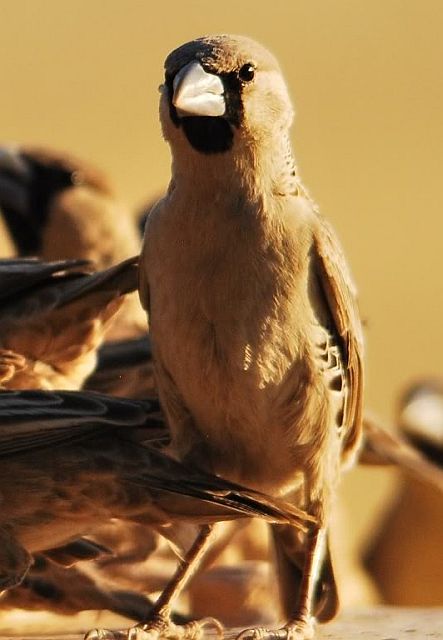
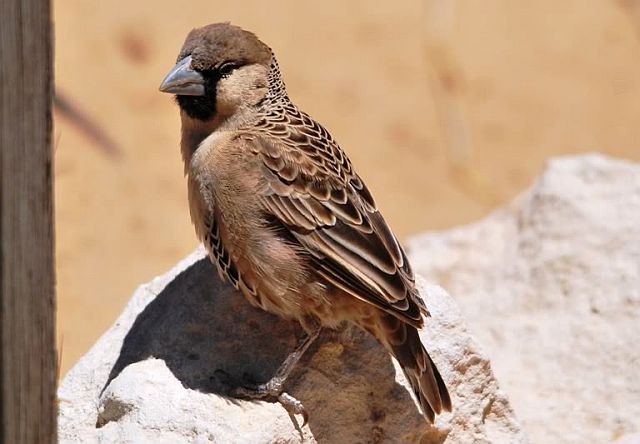
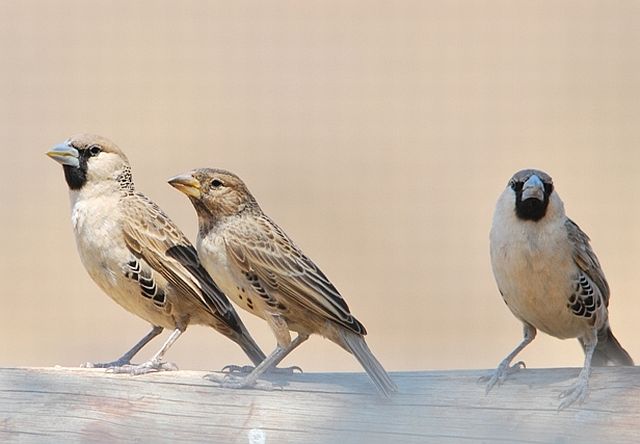
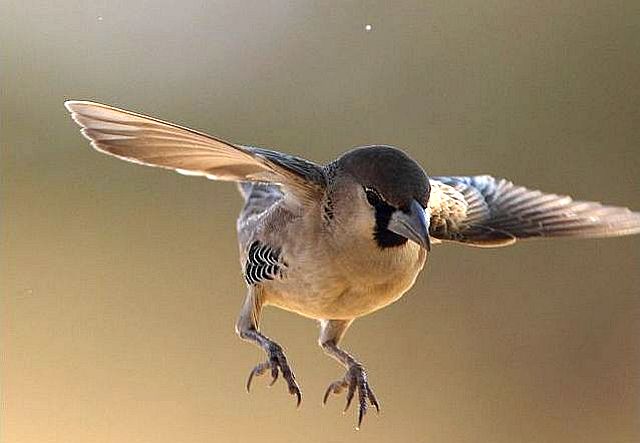 © Sharifa & Duke
© Sharifa & Duke
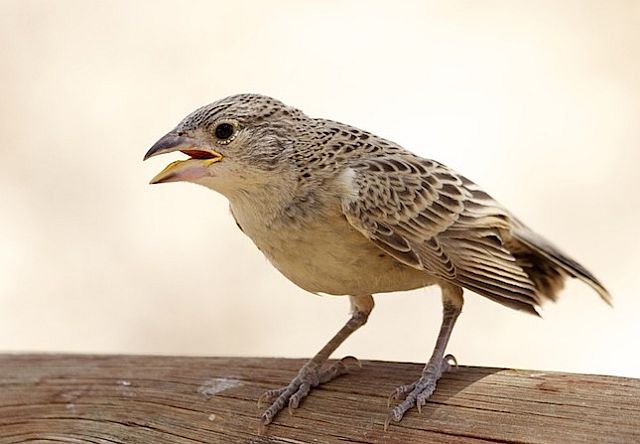 © ExFmem
© ExFmem
Juvenile, Kgalagadi Transfrontier Park
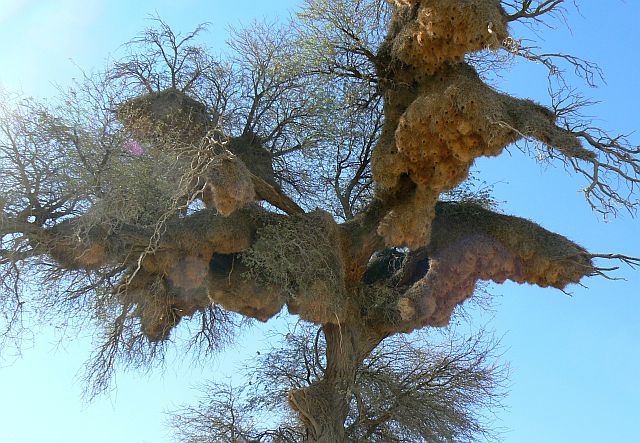 © Toko
© Toko
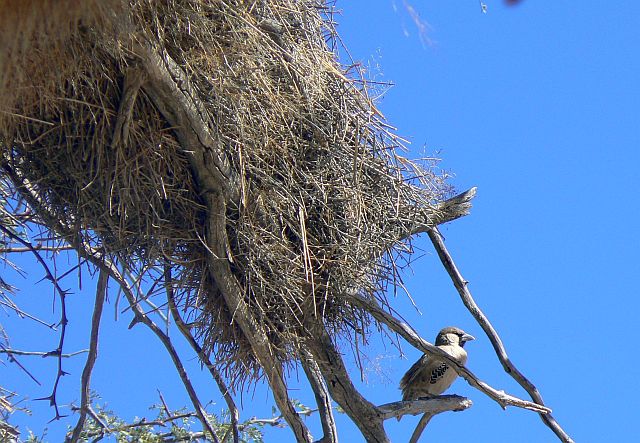 © Toko
© Toko
Amazing facts
Pest control system: Wild Everlasting (Helichrysum) contains a neurotoxin (which, by the way, causes blindness and chronic encephalopathy in sheep and goats). The sociable weaver birds use it at the opening of their nests as an insecticide. After construction they pick dried flowers, (so the toxins are even more concentrated), and stick them around the entryways to the individual nests to ward off insects and parasites.
 © ExFmem
© ExFmem
Links:
http://sabap2.adu.org.za/docs/sabap1/800.pdf
http://sabap2.adu.org.za/spp_summary.ph ... §ion=3
http://www.oiseaux-birds.com/card-sociable-weaver.html
Weaver Watch: Weaver Wednesday
Fact sheet Sociable Weaver
Sociable Weavers and their nests



 © Sharifa & Duke
© Sharifa & Duke © ExFmem
© ExFmemJuvenile, Kgalagadi Transfrontier Park
 © Toko
© Toko © Toko
© TokoAmazing facts
Pest control system: Wild Everlasting (Helichrysum) contains a neurotoxin (which, by the way, causes blindness and chronic encephalopathy in sheep and goats). The sociable weaver birds use it at the opening of their nests as an insecticide. After construction they pick dried flowers, (so the toxins are even more concentrated), and stick them around the entryways to the individual nests to ward off insects and parasites.
 © ExFmem
© ExFmemLinks:
http://sabap2.adu.org.za/docs/sabap1/800.pdf
http://sabap2.adu.org.za/spp_summary.ph ... §ion=3
http://www.oiseaux-birds.com/card-sociable-weaver.html
Weaver Watch: Weaver Wednesday
Fact sheet Sociable Weaver
Sociable Weavers and their nests
God put me on earth to accomplish a certain amount of things. Right now I'm so far behind that I'll never die.
- Flutterby
- Posts: 44029
- Joined: Sat May 19, 2012 12:28 pm
- Country: South Africa
- Location: Gauteng, South Africa
- Contact:
Africa Wild Bird Book
806. Scaly-feathered Weaver, Scaly-feathered Finch Sporopipes squamifrons (Baardmannetjie)
Order: Passeriformes. Family: Ploceidae
Description
An unmistakable small finch with a black-and-white freckled forehead, black malar stripes, and white-fringed wing and tail feathers. White-tipped black feathers on crown and wings give 'scaly' appearance. Has a pink bill and black malar stripe.
Sexes are alike.
Juveniles similar to adults but lack the black malar stripe and scaling on forehead. Bill dusky or horn-yellow.
Distribution
Near-endemic to southern Africa, occurring from Zimbabwe and northern South Africa to Botswana, Namibia and the south-western Angola.
Habitat
Dry Acacia woodland, particularly with small trees; also farmyards and gardens.
Diet
The Scaly-feathered Weaver forages on the ground, feeding mainly on small seeds, with insects being fed to their young.
Breeding
Monogamous, usually solitary nester, although multiple nests may occasionally be clustered in a small area. The nest is a hollow ball made of dry grass stems and inflorescences with a short entrance tunnel, while the interior is lined with fine grass flowers. It often uses the stems and attached flowers of the aromatic Pentzia plant, possibly because the smell repulses ectoparasites. It is typically placed in the thin branches of a thorny tree or bush, sometimes conjoining with an old flycatcher, shrike or weaver nest. Egg-laying season is year round, peaking from about December-June. It lays 2-7 eggs, which are incubated for about 10-12 days. The chicks leave the nest after about 14-18 days.
Call
Shrill kreep krop, kreep krop, as well as soft chizz, chizz, chizz, given by small groups in flight.
Status
Common, near endemic resident. Generally sedentary and usually in small groups of 6-20 birds.
Order: Passeriformes. Family: Ploceidae
Description
An unmistakable small finch with a black-and-white freckled forehead, black malar stripes, and white-fringed wing and tail feathers. White-tipped black feathers on crown and wings give 'scaly' appearance. Has a pink bill and black malar stripe.
Sexes are alike.
Juveniles similar to adults but lack the black malar stripe and scaling on forehead. Bill dusky or horn-yellow.
Distribution
Near-endemic to southern Africa, occurring from Zimbabwe and northern South Africa to Botswana, Namibia and the south-western Angola.
Habitat
Dry Acacia woodland, particularly with small trees; also farmyards and gardens.
Diet
The Scaly-feathered Weaver forages on the ground, feeding mainly on small seeds, with insects being fed to their young.
Breeding
Monogamous, usually solitary nester, although multiple nests may occasionally be clustered in a small area. The nest is a hollow ball made of dry grass stems and inflorescences with a short entrance tunnel, while the interior is lined with fine grass flowers. It often uses the stems and attached flowers of the aromatic Pentzia plant, possibly because the smell repulses ectoparasites. It is typically placed in the thin branches of a thorny tree or bush, sometimes conjoining with an old flycatcher, shrike or weaver nest. Egg-laying season is year round, peaking from about December-June. It lays 2-7 eggs, which are incubated for about 10-12 days. The chicks leave the nest after about 14-18 days.
Call
Shrill kreep krop, kreep krop, as well as soft chizz, chizz, chizz, given by small groups in flight.
Status
Common, near endemic resident. Generally sedentary and usually in small groups of 6-20 birds.
- Flutterby
- Posts: 44029
- Joined: Sat May 19, 2012 12:28 pm
- Country: South Africa
- Location: Gauteng, South Africa
- Contact:
Scaly-feathered Weaver Photos
806. Scaly-feathered Weaver, Scaly-feathered Finch Sporopipes squamifrons (Baardmannetjie)
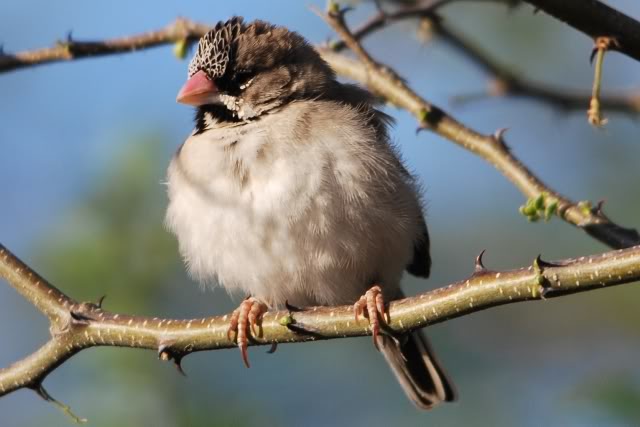 © Mel
© Mel
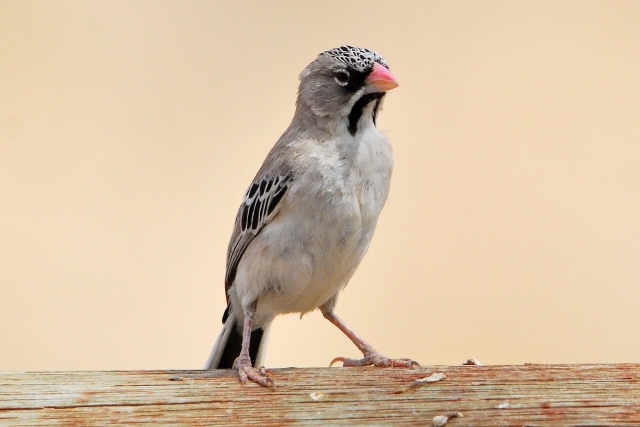 © Mel
© Mel
 © Kesheshe
© Kesheshe
Kgalagadi Transfrontier Park
Links:
Species text Sabap1
Sabap2: http://sabap2.adu.org.za/spp_summary.ph ... §ion=3
Sasol
Weaver Wednesday: Scaly-feathered Finch
 © Mel
© Mel © Mel
© Mel © Kesheshe
© KeshesheKgalagadi Transfrontier Park
Links:
Species text Sabap1
Sabap2: http://sabap2.adu.org.za/spp_summary.ph ... §ion=3
Sasol
Weaver Wednesday: Scaly-feathered Finch
- Flutterby
- Posts: 44029
- Joined: Sat May 19, 2012 12:28 pm
- Country: South Africa
- Location: Gauteng, South Africa
- Contact:
Thick-billed Weaver
807. Thick-billed Weaver Amblyospiza albifrons (Dikbekwewer)
Order: Passeriformes. Family: Ploceidae
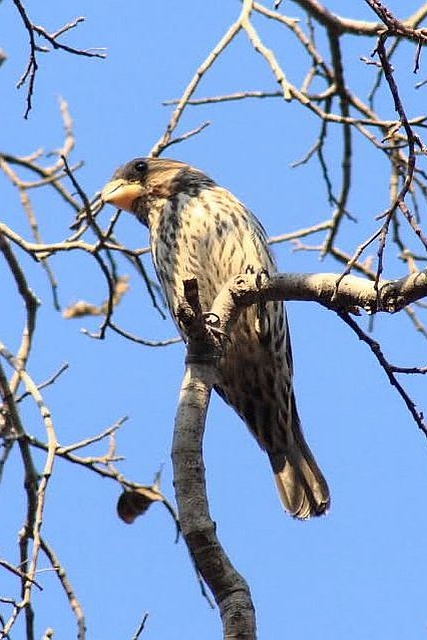
Description
15-17 cm. The largest weaver in the region. The only dark weaver to have a massive, thick bill, which is very deep at the base. The eyes of both genders are brown, the legs and feet grey to black.
Ad male: Overall dark brown; forehead white in br season. Tail blackish brown. Flight feathers blackish; white bases to primaries visible on folded wing and form conspicuous patch in flight. Bill blackish horn or dark grey, heavy and deep. Eyes brown. Legs and feet grey to blackish.
Adult female: Upper parts, incl upper wing coverts, dark brown, scaled buff. Supercilium greyish, indistinct. Tail brown. Flight feathers dark brown, primaries edged paler brown. Underwing coverts and axillaries off-white. Underparts off-white, with heavy dark brown streaks; streaking narrows posteriorly. Undertail coverts with blackish-brown centres. Bill horn-coloured.
Juvenile: As adult female, but upper parts more rufous; underparts buffier. Bill initially yellow, becoming darker.
Similar species: Adult female could be mistaken for ad female Violet-backed Starling, but latter has much more slender, black (not horn-coloured) bill.
Distribution
Occurs in patches of West and East Africa, extending south through Tanzania and northern DRC to Zambia, Angola and southern Africa. Here it is locally common in northern Botswana, Caprivi Strip (Namibia), Zimbabwe's eastern highlands, central and southern Mozambique and north-eastern and south-eastern South Africa.
Native to: Angola (Angola); Benin; Botswana; Burundi; Cameroon; Central African Republic; Congo; Congo, The Democratic Republic of the; Côte d'Ivoire; Equatorial Guinea; Ethiopia; Gabon; Ghana; Guinea; Kenya; Liberia; Malawi; Mozambique; Namibia; Nigeria; Rwanda; Sierra Leone; Somalia; South Africa (along the south-eastern and eastern parts and in Gauteng); South Sudan; Sudan; Swaziland; Tanzania, United Republic of; Togo; Uganda; Zambia; Zimbabwe.
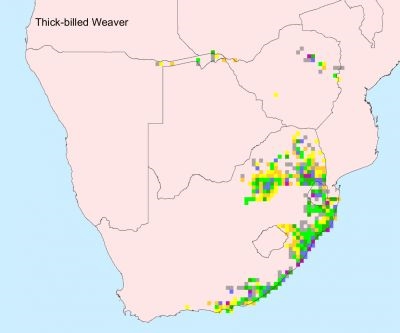
Habitat
Thornveld and dry, scrubby rivercourses. In the breeding season it generally favours marshes, rivers, dams with rank grass, reedbeds and Papyrus (Cyperus papyrus) beds, but in the non-breeding season it prefers edges and clearings in evergreen forest, also occupying reed-beds adjacent to ponds in suburban parks, alien plantations and cultivated areas.
Diet
They forage in the forest canopy eating seeds, fruit, insects and small molluscs.
Breeding
This species is polygynous, the male attempting to attract several females. Colonies may be small with one male, or larger with several males, in a reed patch. The nest is built solely by the male in about 2-12 days, first constructing a cup (unlike other weavers such as Ploceus) over which a dome is woven, forming a globe-shaped structure with a side entrance near the top. Initially the entrance is large, and reduced to a narrow opening if used for breeding. The nest is usually made of woven material, usually Bulrush (Typha capensis) leaves, and once completed and approved by the female she lines the interior with finer material. It is typically suspended between at least two upright stems of Bulrush, reeds (Phragmites) or Papyrus (Cyperus papyrus), more rarely in Garden canna (Canna indica). Sometimes the male builds it in a tree adjacent to marshes, but it is always rejected by the female. Egg-laying season is from November-April. It lays 2-4 eggs, which are incubated solely by the female for about 14-16 days. The chicks are fed solely by the female on a diet of soft larvae, insects and fruit pulp, leaving the nest after about 19-22 days.
Call
Twieek-twieek in flight. Listen to Bird Call.
Status
Common resident.
Order: Passeriformes. Family: Ploceidae

Description
15-17 cm. The largest weaver in the region. The only dark weaver to have a massive, thick bill, which is very deep at the base. The eyes of both genders are brown, the legs and feet grey to black.
Ad male: Overall dark brown; forehead white in br season. Tail blackish brown. Flight feathers blackish; white bases to primaries visible on folded wing and form conspicuous patch in flight. Bill blackish horn or dark grey, heavy and deep. Eyes brown. Legs and feet grey to blackish.
Adult female: Upper parts, incl upper wing coverts, dark brown, scaled buff. Supercilium greyish, indistinct. Tail brown. Flight feathers dark brown, primaries edged paler brown. Underwing coverts and axillaries off-white. Underparts off-white, with heavy dark brown streaks; streaking narrows posteriorly. Undertail coverts with blackish-brown centres. Bill horn-coloured.
Juvenile: As adult female, but upper parts more rufous; underparts buffier. Bill initially yellow, becoming darker.
Similar species: Adult female could be mistaken for ad female Violet-backed Starling, but latter has much more slender, black (not horn-coloured) bill.
Distribution
Occurs in patches of West and East Africa, extending south through Tanzania and northern DRC to Zambia, Angola and southern Africa. Here it is locally common in northern Botswana, Caprivi Strip (Namibia), Zimbabwe's eastern highlands, central and southern Mozambique and north-eastern and south-eastern South Africa.
Native to: Angola (Angola); Benin; Botswana; Burundi; Cameroon; Central African Republic; Congo; Congo, The Democratic Republic of the; Côte d'Ivoire; Equatorial Guinea; Ethiopia; Gabon; Ghana; Guinea; Kenya; Liberia; Malawi; Mozambique; Namibia; Nigeria; Rwanda; Sierra Leone; Somalia; South Africa (along the south-eastern and eastern parts and in Gauteng); South Sudan; Sudan; Swaziland; Tanzania, United Republic of; Togo; Uganda; Zambia; Zimbabwe.

Habitat
Thornveld and dry, scrubby rivercourses. In the breeding season it generally favours marshes, rivers, dams with rank grass, reedbeds and Papyrus (Cyperus papyrus) beds, but in the non-breeding season it prefers edges and clearings in evergreen forest, also occupying reed-beds adjacent to ponds in suburban parks, alien plantations and cultivated areas.
Diet
They forage in the forest canopy eating seeds, fruit, insects and small molluscs.
Breeding
This species is polygynous, the male attempting to attract several females. Colonies may be small with one male, or larger with several males, in a reed patch. The nest is built solely by the male in about 2-12 days, first constructing a cup (unlike other weavers such as Ploceus) over which a dome is woven, forming a globe-shaped structure with a side entrance near the top. Initially the entrance is large, and reduced to a narrow opening if used for breeding. The nest is usually made of woven material, usually Bulrush (Typha capensis) leaves, and once completed and approved by the female she lines the interior with finer material. It is typically suspended between at least two upright stems of Bulrush, reeds (Phragmites) or Papyrus (Cyperus papyrus), more rarely in Garden canna (Canna indica). Sometimes the male builds it in a tree adjacent to marshes, but it is always rejected by the female. Egg-laying season is from November-April. It lays 2-4 eggs, which are incubated solely by the female for about 14-16 days. The chicks are fed solely by the female on a diet of soft larvae, insects and fruit pulp, leaving the nest after about 19-22 days.
Call
Twieek-twieek in flight. Listen to Bird Call.
Status
Common resident.
- Flutterby
- Posts: 44029
- Joined: Sat May 19, 2012 12:28 pm
- Country: South Africa
- Location: Gauteng, South Africa
- Contact:
Thick-billed Weaver Photos
807. Thick-billed Weaver Amblyospiza albifrons (Dikbekwewer)
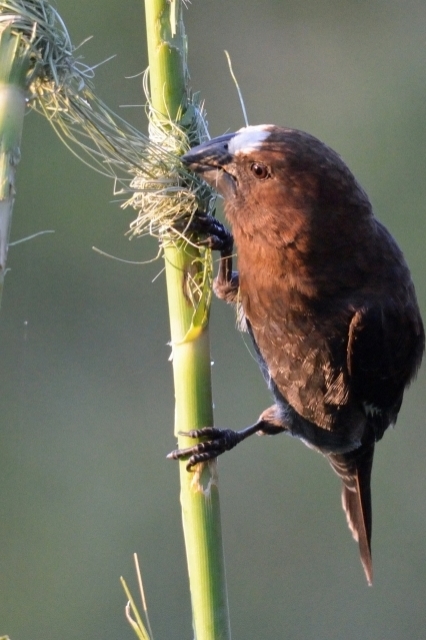 © BluTuna
© BluTuna
Male
 © Pumbaa
© Pumbaa
Male, Kruger National Park, Sweni Hide
 © Heksie
© Heksie
Male
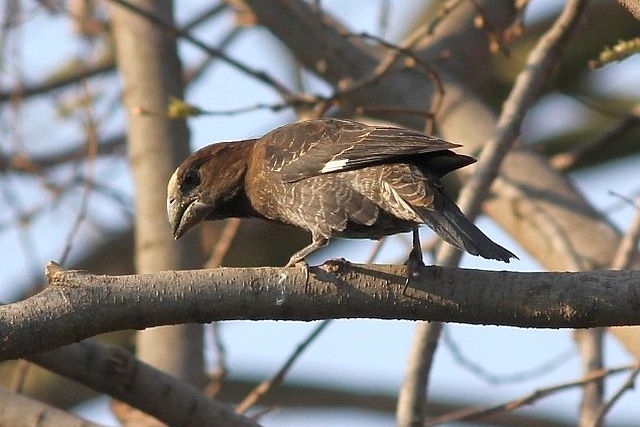 © Amoli
© Amoli
Male
 © BluTuna
© BluTuna
Female
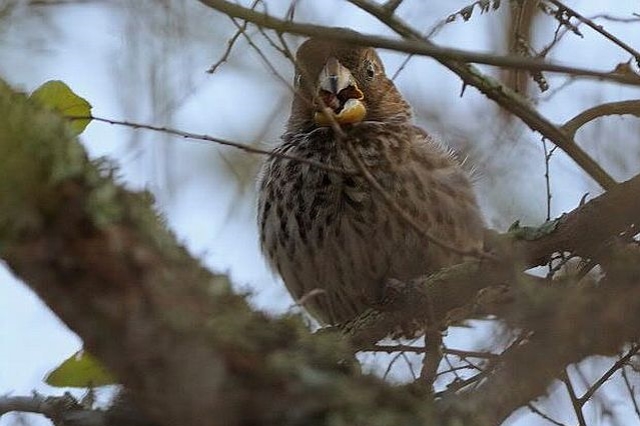 © Dewi
© Dewi
Juvenile
 © BluTuna
© BluTuna
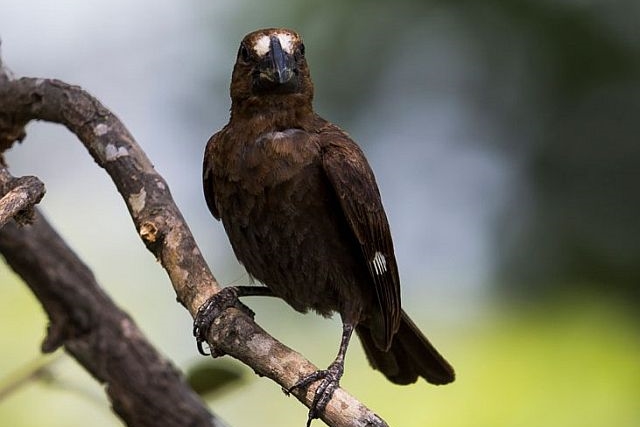 © Pumbaa
© Pumbaa
Kruger National Park
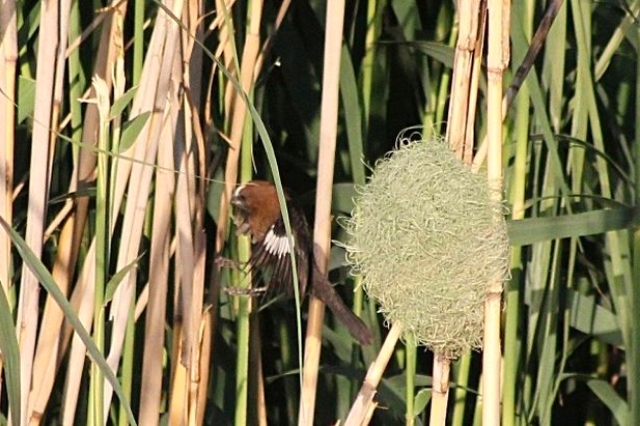 © Amoli
© Amoli
Nest in the Rietvlei Nature Reserve, Gauteng
Links:
http://sabap2.adu.org.za/docs/sabap1/807.pdf
http://sabap2.adu.org.za/species_info.p ... #menu_left
http://weavers.adu.org.za/newstable.php?id=251
 © BluTuna
© BluTunaMale
 © Pumbaa
© PumbaaMale, Kruger National Park, Sweni Hide
 © Heksie
© HeksieMale
 © Amoli
© AmoliMale
 © BluTuna
© BluTunaFemale
 © Dewi
© DewiJuvenile
 © BluTuna
© BluTuna © Pumbaa
© PumbaaKruger National Park
 © Amoli
© AmoliNest in the Rietvlei Nature Reserve, Gauteng
Links:
http://sabap2.adu.org.za/docs/sabap1/807.pdf
http://sabap2.adu.org.za/species_info.p ... #menu_left
http://weavers.adu.org.za/newstable.php?id=251
Spectacled Weaver
810. Spectacled Weaver Ploceus ocularis (Brilwewer)
Order: Passeriformes. Family: Ploceidae
Description
Size 14-15 cm. Unlike many other weaver species, Spectacled Weavers have the same bright yellow plumage year round. Olive above, yellow below with a chestnut cap and face. Distinctive pale yellow eye with black line through. Bill black and sharply pointed.
Sexes are similar but the female lacks the black throat of the male.
The juvenile has a pinkish bill, without the eye-stripe initially but can be distinguished from other weavers by its thin bill.
Distribution: From Ethiopia to Cameroon south through southern DRC, Zambia, Angola and Tanzania to southern Africa. Here it is locally common in Zimbabwe, Mozambique, Swaziland and eastern and south-eastern South Africa, but scarce in northern Botswana and Namibia.
P. o. crocatus: se Nigeria and Cameroon to sw Ethiopia, w Kenya, nw Tanzania, Angola, n Namibia and nw Botswana. Includes tenuirostris
P. o. suahelicus: e Kenya to Mozambique
P. o. ocularis: extreme s Mozambique and ne, e South Africa
Habitat
Thornveld and coastal forests, sandforests and riverine forests.
Diet
It mainly eats insects gleaned from branches, supplemented with fruit. It is an agile foraging, rapidly moving through foliage in search prey and occasionally hawking termite alates.
Breeding
Monogamous, territorial solitary nester, as pairs stay bonded over multiple breeding seasons, possibly for life. Pairs often nest at the same site every year. The nest is built solely by the male or occasionally by both sexes in about 2-3 weeks, consisting of a retort-shaped structure with an exceptionally long vertical entrance tunnel, usually 10-20 but sometimes 60 cm long! It is usually woven from thin strips of plant material, but it may be built with only pine (Pinus) needles or horse hair. It is typically attached to the tip of a branch or creeper, especially if overlooking a stream, rarely using a patch of reeds or grass instead. Egg-laying season is from September-March, peaking from October-February. The female lays 1-4 eggs, which are incubated by both sexes for about 13-14 days. The chicks are fed by both parents, leaving the nest after about 15-19 days and becoming fully independent about two weeks later.
It is an occasional host of the Diederik Cuckoo.
Call
A descending dee-dee-dee-dee-dee. Listen to Bird Call.
Status
Common resident.
Order: Passeriformes. Family: Ploceidae
Description
Size 14-15 cm. Unlike many other weaver species, Spectacled Weavers have the same bright yellow plumage year round. Olive above, yellow below with a chestnut cap and face. Distinctive pale yellow eye with black line through. Bill black and sharply pointed.
Sexes are similar but the female lacks the black throat of the male.
The juvenile has a pinkish bill, without the eye-stripe initially but can be distinguished from other weavers by its thin bill.
Distribution: From Ethiopia to Cameroon south through southern DRC, Zambia, Angola and Tanzania to southern Africa. Here it is locally common in Zimbabwe, Mozambique, Swaziland and eastern and south-eastern South Africa, but scarce in northern Botswana and Namibia.
P. o. crocatus: se Nigeria and Cameroon to sw Ethiopia, w Kenya, nw Tanzania, Angola, n Namibia and nw Botswana. Includes tenuirostris
P. o. suahelicus: e Kenya to Mozambique
P. o. ocularis: extreme s Mozambique and ne, e South Africa
Habitat
Thornveld and coastal forests, sandforests and riverine forests.
Diet
It mainly eats insects gleaned from branches, supplemented with fruit. It is an agile foraging, rapidly moving through foliage in search prey and occasionally hawking termite alates.
Breeding
Monogamous, territorial solitary nester, as pairs stay bonded over multiple breeding seasons, possibly for life. Pairs often nest at the same site every year. The nest is built solely by the male or occasionally by both sexes in about 2-3 weeks, consisting of a retort-shaped structure with an exceptionally long vertical entrance tunnel, usually 10-20 but sometimes 60 cm long! It is usually woven from thin strips of plant material, but it may be built with only pine (Pinus) needles or horse hair. It is typically attached to the tip of a branch or creeper, especially if overlooking a stream, rarely using a patch of reeds or grass instead. Egg-laying season is from September-March, peaking from October-February. The female lays 1-4 eggs, which are incubated by both sexes for about 13-14 days. The chicks are fed by both parents, leaving the nest after about 15-19 days and becoming fully independent about two weeks later.
It is an occasional host of the Diederik Cuckoo.
Call
A descending dee-dee-dee-dee-dee. Listen to Bird Call.
Status
Common resident.
Dewi
What is the good of having a nice house without a decent planet to put it on? (H D Thoreau)
What is the good of having a nice house without a decent planet to put it on? (H D Thoreau)
Spectacled Weaver Photos
810. Spectacled Weaver Ploceus ocularis


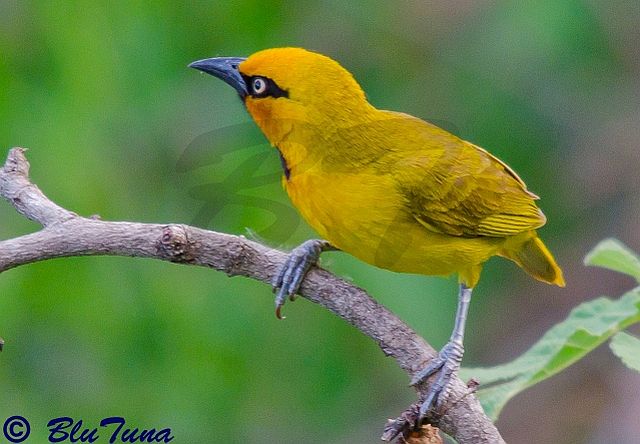 © BluTuna
© BluTuna
Male
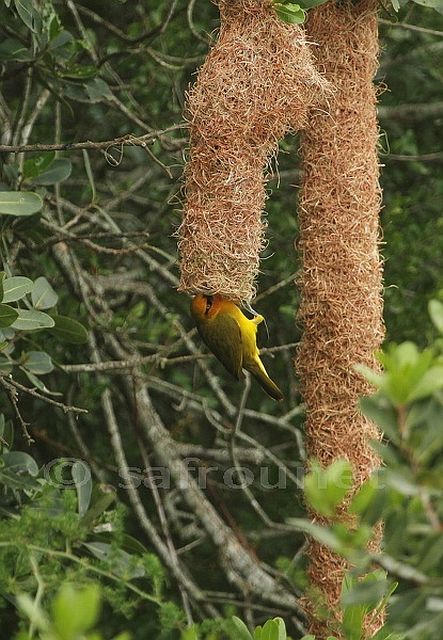 © nan
© nan
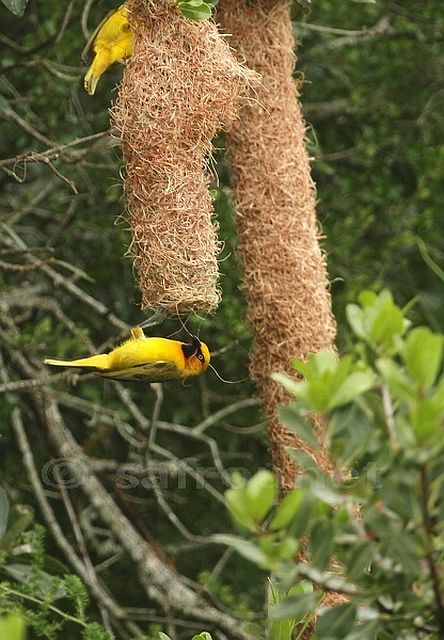 © nan
© nan
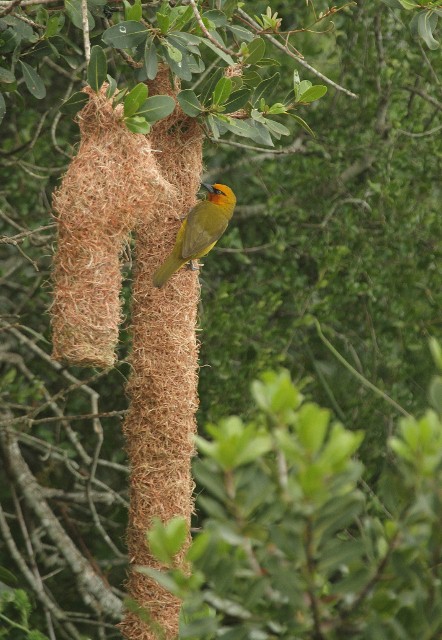 © nan
© nan
Spectacled Weaver nest
Links:
http://sabap2.adu.org.za/docs/sabap1/810.pdf
http://sabap2.adu.org.za/spp_summary.ph ... §ion=3]Sabap2[/url]
Weaver Watch: Spectacled Weaver


 © BluTuna
© BluTunaMale
 © nan
© nan © nan
© nan © nan
© nanSpectacled Weaver nest
Links:
http://sabap2.adu.org.za/docs/sabap1/810.pdf
http://sabap2.adu.org.za/spp_summary.ph ... §ion=3]Sabap2[/url]
Weaver Watch: Spectacled Weaver
Dewi
What is the good of having a nice house without a decent planet to put it on? (H D Thoreau)
What is the good of having a nice house without a decent planet to put it on? (H D Thoreau)


